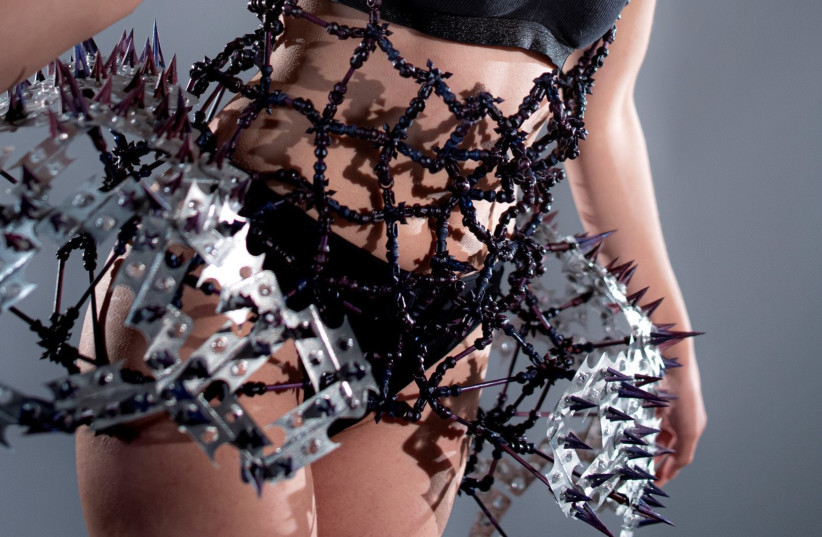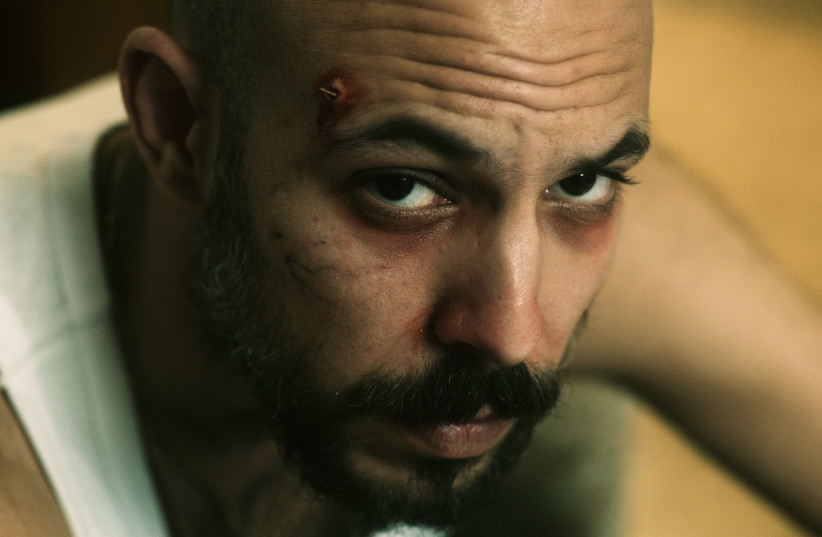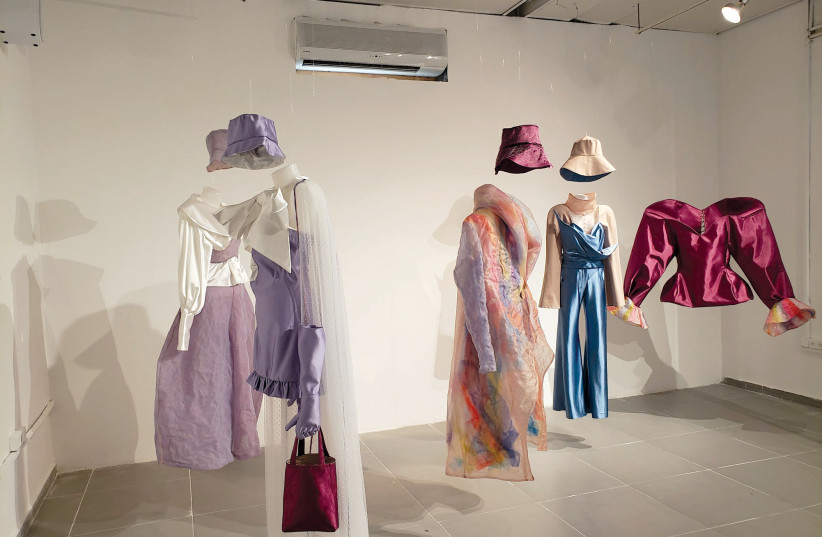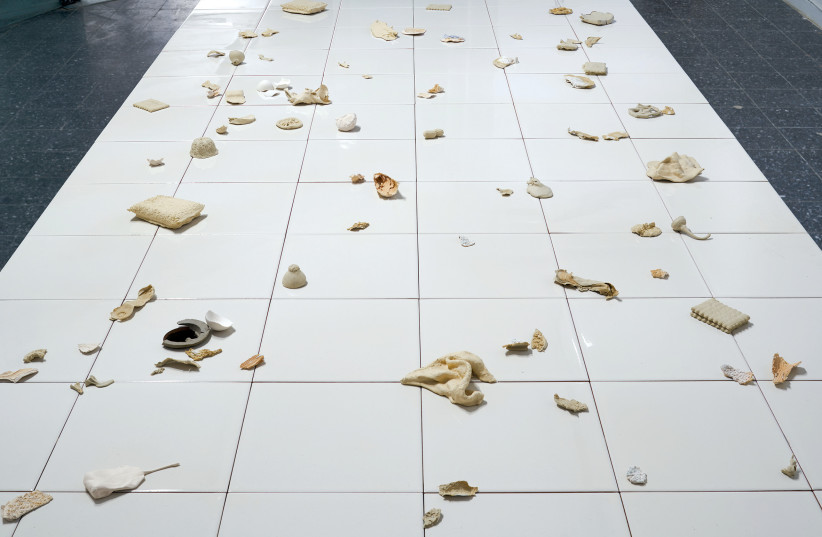This year’s exhibition by graduates of the Bezalel Academy of Arts and Design kicked off in early July at the Mount Scopus campus.
Of the hundreds of projects, I was only able to focus on a few, but I did have the pleasure of speaking to nine graduates whose work was featured in the exhibition.
Focusing on the experience of fibromyalgia
An interesting through line I quickly noticed was the desire to communicate pain.
This is especially evident in Nuriel Gavish Yamin’s piece, Fibro-Glam Kit. The design is reminiscent of a cage or chain-link armor. Upon closer inspection, you can see that the piece is studded with aluminum pill containers.
Yamin knew from the beginning that her final project would focus on her experience of fibromyalgia; she began saving her pill containers years ago with the intent to repurpose them. However, her enrollment at Bezalel was not easy. Growing up with undiagnosed chronic pain and ADHD left her on the sidelines socially and academically.

When I spoke with her, Yamin described the pain of offering the world her talents and being perpetually rejected. She dreamed of being a designer and an artist but could not imagine those dreams ever coming true.
After high school, National Service and several years in the workforce, she returned to matriculation exams armed with the proper resources and support. She scored extremely high and, consequently, was one of the oldest students in her program. But after everything Yamin had been through, she did not let that shake her confidence.
Yamin combined her love of goth and steampunk styles with expression of chronic pain. Fibro-Glam Kit brings internal pain into the visual world. There is something very viscerally human about pain that the piece communicates extremely successfully. The project was a personal victory for Yamin, a celebration of having made her own dreams come true.
Flora: A short film of pain and beauty
Pain and the beauty that can accompany it were also a key element in Omer Dolev’s short film Flora.
In the documentary-style film, alien flowers fall to Earth and infect those who touch them with the “Flora” disease. First they develop a rash, then thorns begin to sprout from their skin, which, over time, become flowers. The process is slow, bloody and ultimately fatal. The audience meets three individuals at different stages of the disease.
The grotesque beauty on screen caught my eye initially, and the powerful message about the relationship between beauty and pain kept me watching twice through. Something as innocent and beautiful as a flower can bring an onslaught of torture.

Dolev has a knack for connecting with people. During our chat, we tearfully bonded over the shared experiences of holding our dogs in our arms as they took their last breaths. He had similar conversations with his actors during shoot days, encouraging them to tap into their own memories for inspiration.
Dolev’s experiences with the stages of grief after losing family members to cancer were his primary inspiration, although he admits to being subconsciously influenced by the coronavirus pandemic.
I was genuinely moved by the film. The acting was phenomenal. I felt the grief and fear of someone waiting for death alone. I shared in the absurdity of contemplating what kind of flowers to lay on the grave of someone who died as their body literally turned into a bed of flowers. I resonated with the feeling of profound hollowness that even the longest shower can barely cut through. Most of all, I appreciated that the film did not glorify grief. The combination of beautiful flowers and deadly disease served to highlight the terror that can accompany beauty, not the beauty that accompanies terror.
Shatnez and sewing secular and religious Jewish life together
THE NEXT grouping I noticed was of projects straddling two worlds. In particular, the secular and religious Jewish worlds came into play quite a bit.

Shatnez refers to cloth made of both wool and linen, which in Judaism is strictly forbidden to wear. Adi Dvir’s Shatnez collection represents Dvir’s own journey of sewing together secular and religious life.
Dvir was raised by a secular father and a religious mother, attending secular schools while living in a largely hassidic neighborhood. She became religious at age 16, while attending a secular high school. She began to dress more modestly and distance herself from men, but kept her friends and her social life. She had no intention of giving anything up.
Dvir designed all the fabrics from scratch. Each piece includes fabric printed with the Star of David. Religious iconography was a priority for her, as were bold colors. In her own words, “I combined my love of colors and art with the faith and Judaism that I am proud of.”
“I combined my love of colors and art with the faith and Judaism that I am proud of.”
Adi Dvir
Beginning of Love: Judaica for a couple's Shabbat
Naama Altalef Blau’s In the Beginning of Love is a series of Shabbat-related Judaica in which each piece is designed to be used by two people at the same time. The series was born of Blau’s efforts to invite her secular husband into her religious Shabbat, which were hindered by the objects. They are designed for either one person or a whole family. Blau wanted a couple’s Shabbat.
Each vessel fosters intimacy. The pieces are all very round, and designed to become more and more unified as Shabbat progresses. Two Shabbat candles morph into one double-wicked havdalah candle.
Blau also pointed out that the basic elements of our universe, from atoms to entire solar systems, are built on circles, orbits, spheres. Shabbat itself is bounded by one rotation of the Earth, a foundational roundness that holds a central place in Judaism as well as secular life.
A Picture from the Road: Bringing the home to work
THE SECOND set of worlds bound together by Bezalel grads is the realm of home and work life.

Evette Hammoud, maker of A Picture from the Road, spent four years traveling between Yirka, a Druze village far in the north of Israel, and Jerusalem, for school.
Hammoud was taken in by the beauty of the journey, the colors of the sky, the northern Israeli landscape. She also incorporated the feeling of enclosure in her car and her constant uprooting, always hauling her luggage.
When she looked back on her studies in preparation for the final project. “In the end, I understood that the most important thing, the thing I truly love – truly, out of the whole experience and all of my studies – is the trip,” she said.
“In the end, I understood that the most important thing, the thing I truly love – truly, out of the whole experience and all of my studies – is the trip.”
Evette Hammoud
Hammoud employed her passion for style and eveningwear to create clothes that held within them the colors of the journey.
“In my collection,” she wrote, “I present this experience that brings joy to my soul; colorful scenes, layers of fabric, the long road, the clothes that cover and embrace the body, the detailed corridors, intersections and mountains.”
In effect, she bridged her two worlds by bringing the journey between them back to Bezalel and showing it to the world.
Remnant.Action: Fusing domestic life and career
Ester Tsalisher’s project, Remnant.Action, combines the domestic and the career-oriented. Juggling ceramic work at Bezalel with motherhood and household chores, Tsalisher found herself encountering a lot of “she’eriot,” which can be translated as “leftovers” or “bits and pieces.” This, for her, exemplified “the tension between the household and art.”
Her project is on display in its own room, with a table and several screens. The table holds the ceramic leftovers. We see eggshells, tea biscuits, a sponge, a scrunched-up washcloth, and a myriad of other odds and ends.

The screens show the processes of cooking, cleaning and working. Critically, however, all the housework is being done with clay or gray clay-water. The overall effect is calming. There is a rhythm to the process; artistic work and household chores are not opposites. Tsalisher’s work shows us that if you simply change your point of view, inconsistencies can align and become a single pattern.
Knitting Independence: Left handed in a right handed world
Lady Salman also wanted to combine home and work life with her project titled Knitting Independence.
Growing up left-handed in a traditional Muslim household, Salman was strongly encouraged to use her right hand because “the devil participates in our food, and the blessing of the food is gone” if one eats with the left hand.
She developed ambidexterity and has come to view using her left hand as a form of self-determination and independence.
When her daughter, now a toddler, was less than one year old, Salman handed her a spoon, which she grasped in her left hand. A spoon, too, is a sign of independence – a child who can use cutlery becomes less reliant on his/her parents when eating.
With all this in mind, Salman “knit a collection of spoons symbolizing independence, gratitude and giving feelings, continuing to foster old and new memories.”
Salman currently designs and creates handmade jewelry. She is particularly interested in incorporating 3D printing into her jewelry business.
Meeting Point: Centering on the process of creation
THE NEXT theme I encountered was using the process as art. Blau and Tsalisher touched on this: Blau described metal-working (especially creating spheres) as a very embodied experience. Tsalisher, of course, was entirely focused on the process and the bits and pieces that get tossed aside while work gets done.
Mor Grouchko’s Meeting Point, too, was entirely centered on the physical process of creation.
Grouchko mostly studied jewelry and metalwork in her time at Bezalel and decided to shake things up for her final project. She dove headfirst into the act of weaving.
“The repetitive rhythm created the thread combination that was right for me; the cotton was influenced and absorbed the different actions of my hands; and the metal captured the collection of sensations that ran through me,” Grouchko explained. “At certain moments, I felt the gap between the pace of my surroundings, fast and forced, [and] my natural pace, one with the flora and fauna and the repetition of the seasons, from which the rhythm of my hands [is] derive[d].”
The result is a semi-abstract series of cloths presented as a cohesive group.
The title of her work, “Meeting Point,” refers to literal meeting points of threads through knots and intersections. But the true meeting point was between the artist and the art, the physical moments of encounter before the cloth is complete and must be displayed.
Grouchko said that one of the most startling moments of the project was having to put the pieces on models and see how they interact with the human body as complete entities.
Although the cloths themselves appear simple, there is a lot to be learned from their creation.
Gender Blender: Blurring lines between gender-specific clothing
THE FINAL work I examined in detail does not fit into any of the previous categories, which itself is fitting. Or Menahem’s Gender Blender deliberately defies category, blurring the lines between the traditional dichotomy of men’s and women’s clothing. No single article of clothing in the collection was obviously meant for a specific kind of person.
The piece that most spoke to me was the bra purse. Two cups of a brassiere were fastened together with an opening left at the top to create a receptacle; a chain of metal rings allows for carrying. This is clever on many levels and turns the brassiere into a more gender-neutral item.
Menahem is interested in the world of lingerie design and hopes to design men’s underwear and perhaps break free of the traditional options.
I could spend pages describing each project, and I would happily lose my voice interviewing each artist whose work spoke to me.
I have been very complimentary so far, but I am aware that not all art is good. Obviously, some works at the exhibition fell flat. I simply found it much more interesting to highlight artists I liked rather than tear down some art students who didn’t give their best effort. Perhaps it was the fact that the nine students I met were so lovely and thoughtful that gave me rose-colored glasses in retrospect.
Still, I cannot help but recommend seeking out a recent Bezalel graduate if you are looking for a new local artist to patronize or simply seeking some food for thought. ❖
